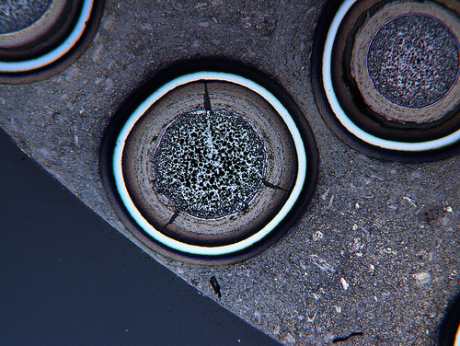Research teams at two US national laboratories have found that irradiated carbon-coated Triso fuel particles are even more resistant to extreme temperatures than previously thought, offering potential benefits for reactor safety.
 |
| Microscopic cross-section of Triso fuel particles (Image: INL) |
Three years of studies by teams at the US Department of Energy's Idaho National Laboratory (INL) and Oak Ridge National Laboratory (ORNL) have found that most fission products remain inside irradiated Triso particles even at temperatures of 1800°C - more than 200°C hotter than in postulated accident conditions.
Triso (tristructural-isotropic) fuel particles are triple-coated spherical particles of uranium fuel, less than one millimetre in diameter. A uranium centre is coated by a layer of carbon, which is then coated by silicon carbide, with an outer shell of carbon. In effect, this gives each tiny particle its own primary containment system. The particles are then fabricated into fuel pellets.
The latest study involved irradiating capsules of the fuel in the core of INL's Advanced Test Reactor for three years. The irradiated fuel was then tested in high-temperature furnaces at INL and ORNL to investigate the fate of fission products in the fuel at and above the high temperatures postulated to occur in accident situations. In the words of David Petti, director of the Very High Temperature Reactor Technology Development Office at INL, the release of fission products from the pellets was found to be "very low".
The fuel's performance, both during irradiation and throughout the high-temperature testing, exceeded the expectations of the research teams, according to ORNL project leader John Hunn. Most fission products remained inside the particles, but Hunn said that his team were able to identify the few individual particles that did secrete caesium and isolate them for further analysis. "Careful study of these few defective particles, along with the numerous particles that perform well, allows us to complete the Triso fuel development circle by connecting the fabrication process and material properties to performance in the reactor," he said.
Various projects around the world are developing high-temperature gas-cooled nuclear reactors which use Triso-type fuel, building on many years of research. The fuel itself was developed primarily in Germany during the 1980s. The US teams have been studying their version of the fuel since 2002, and the findings have direct implications for the safety for advanced high-temperature reactors, the researchers say. Petti said that the researchers intend to probe the particles' limits still further: "If the fuel performs well at 1800°C, what about higher temperatures?"
Researched and written
by World Nuclear News




_18570.jpg)
_16159.jpg)
_18938.jpg)
_33584.jpg)





